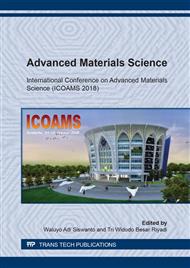p.23
p.30
p.39
p.45
p.51
p.57
p.65
p.73
p.80
Mechanical Properties of Concrete Block Reinforced with Recycle HDPE and Coal Bottom Ash
Abstract:
Garbage is a serious problem if it is not managed properly, both organic and non-organic. Inorganic waste, for example, plastic, metal, glass, and charcoal from coal combustion are difficult to decompose in the soil. HDPE (high-density polyethylene) plastic is one type of inorganic waste that is difficult to decompose, but this plastic can be recycled. The objective of the study is to develop light cement blocks by using the waste of HDPE, coal bottom ash and cement. The research guide was referred to SNI (Indonesian National Standard). The SNI-03-6825-2002 is for testing of the compressive strength and SNI 03-0349-1989 for the testing of the water absorption. The size of the specimen was 5 x 5 x 5 cm. In this study, the compositions of HDPE: coal bottom ash were varied by 70%: 0%, 60%: 10%, 50%: 20%, and 40%: 30%. The Holcim cement was 30% of the volume fraction. Testing was conducted after the specimens stay in 7 and 28 days. For the 7 days old of specimens, the highest compressive strength has resulted from 50%:20% composition with the value of 5.88 N/mm2. For the 28 days old specimens, the highest compressive strength was 8.34 N/mm2. The lowest water absorption test was delivered by the more coal bottom ash in the composition of 40%:30%. It was 16.971%. The more coal bottom ash, the less water absorption. The mean of specimens density was 1.076 gr/cm3. The result of the research shows that recycles HDPE and coal bottom ash as concrete block meet the required strength.
Info:
Periodical:
Pages:
51-56
Citation:
Online since:
July 2019
Keywords:
Price:
Сopyright:
© 2019 Trans Tech Publications Ltd. All Rights Reserved
Share:
Citation:


